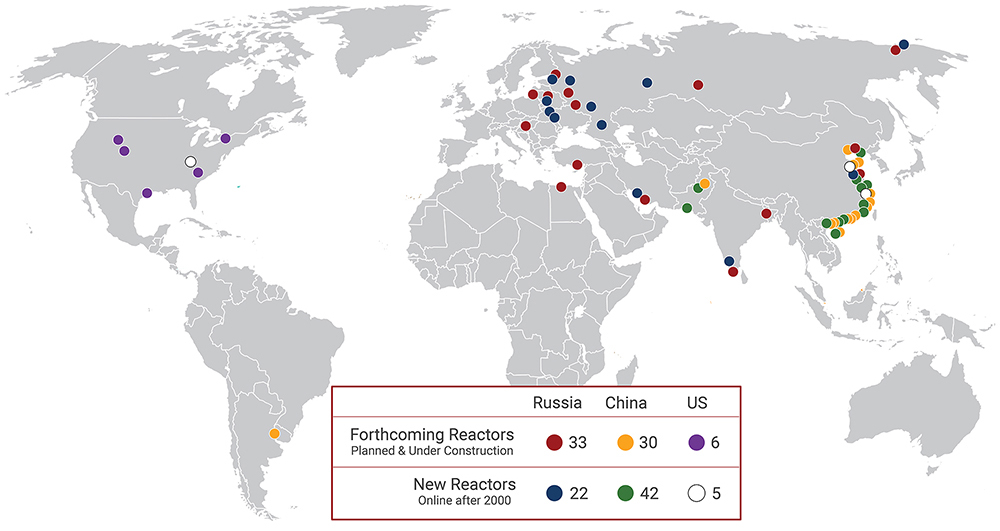Posted on August 15, 2023 by Natalie Houghtalen
The first step in establishing American clean energy leadership abroad is building a secure nuclear fuel supply chain at home. Realizing the true value of nuclear power in ensuring energy security and electricity reliability must start with understanding the supply risk of nuclear fuel on the global stage.
This year, the Department of Energy (DOE) took a positive step adding uranium, the material used to generate nuclear energy, to its Critical Material Assessment. Uranium scored 4 out of 4 on its importance to energy — which makes sense given nuclear energy is producing 20% of U.S. electricity. Uranium was recognized this year because of nuclear energy’s massive potential to balance variable renewable energy on the grid and provide clean heat to the industrial sector, a sector that accounts for 24% of the emissions in the U.S.
“Nuclear energy is believed to continue to play an important role in the future for carbon-free
energy generation although with higher uncertainties compared to other power sources.”
– DOE, 2023 Critical Material Assessment
Unfortunately, compared to the 4 out of 4 score for its importance to energy, the DOE only rates the overall risk of supply chain disruption of uranium at a 2 out of 4. This low score does not align with the industry’s current state. There are a few reasons the DOE may have underestimated the potential for supply chain disruption. First, the political, regulatory, and social factors (PRS) metric relies on 2021 data which was released prior to the Russian invasion of Ukraine. Secondly, the assessment takes a global view of material demand and does not necessarily reflect how important certain materials are to the U.S. energy sector or economy. From the report’s data and assumptions, the DOE has underestimated the potential of a uranium supply disruption from the American perspective.

Source: Department of Energy, 2023 Critical Material Assessment
Transforming uranium ore into nuclear fuel requires a number of steps. In order to make nuclear fuel, the uranium must be mined, milled, converted to a gas, isotopically enriched, deconverted to a powder, and then fabricated into fuel pellets. Enrichment is a necessary step that increases the concentration of usable energy in nuclear fuel so it is compatible with U.S. reactors. However, in 2022, U.S. nuclear plants purchased almost 75% of our enrichment services from other countries, and more than 20% of total enrichment services were provided by Russia. In fact, the report’s limited post-Ukraine invasion data likely undervalues the severity of the supply chain bottleneck in Russia.
In addition to the supply constraints of LEU, the U.S. has no commercial capacity to produce a higher-enriched fuel called high-assay, low-enriched uranium (HALEU), which requires new infrastructure and additional domestic LEU production as feedstock. HALEU-enriched fuel is necessary for several advanced test and demonstration reactors coming online in the next decade. These advanced reactors must be proven domestically before they are exported and sold to compete against Russia and China in the international nuclear energy market. American leadership, innovative technologies, and strong safety and security standards are the comparative advantages that the U.S. wields against our adversaries.
New nuclear energy is coming online globally, but the United States must do more to lead. Since 2000, Russia and China collectively brought 64 new nuclear reactors online. Only six U.S.-designed reactors were built during that same time. Most recently, Plant Vogtle, in Georgia, announced its newest reactor, which can power an estimated 500,000 homes and businesses, entered commercial operation on July 31st, 2023. Due to the success of that project, it’s clear that America is ready to deploy new nuclear power. Now the U.S. needs to secure its place in the global nuclear industry and capitalize on Georgia’s accomplishment.
New and Forthcoming Reactors Worldwide

Map built using information from – American Nuclear Society “25th Annual NuclearNews Reference Section” Nuclear News: The International Issue, March 2023.
There are a number of barriers in need of targeted policy and efficient federal execution, but a major hurdle in building and deploying new nuclear energy is nuclear fuel insecurity. That is why DOE’s recent rating of 2 for uranium security is confusing.
The U.S. Senate overwhelmingly agrees with the importance of strengthening America’s domestic LEU production capacity to support our existing reactors and creating a HALEU production capacity to support advanced reactors. On July 27th, the Senate voted 96-3 in favor of including legislation that improves American nuclear energy security into the National Defense Authorization Act (NDAA), which passed the Senate later that same day. The House-passed version of the NDAA was largely limited to Department of Defense-centric policies, so it is likely these policies will garner great attention when the House and Senate work to reconcile their bills.
The U.S. must establish a nuclear fuel supply chain at home in order to secure domestic nuclear energy production and power the next-generation nuclear fleet, leading to the export of U.S. technologies. America must provide an exportable, dispatchable, dependable alternative to Russian and Chinese nuclear reactors. Building a secure nuclear fuel supply chain at home starts with realizing the risk, and working on policy to minimize that risk. The inclusion of the nuclear fuel provision in the Senate defense bill and the DOE’s designation of uranium as a near-critical material are putting the U.S. on a stronger path towards international leadership and energy security.
